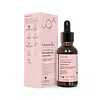What's inside
What's inside
 Key Ingredients
Key Ingredients

 Benefits
Benefits

 Ingredients Side-by-side
Ingredients Side-by-side

Water
Skin ConditioningTranexamic Acid
AstringentDimethyl Isosorbide
SolventEthoxydiglycol
HumectantPropanediol
SolventAlpha-Arbutin
AntioxidantPhenoxyethanol
PreservativeEthylhexylglycerin
Skin ConditioningHydroxyethylcellulose
Emulsion StabilisingBetaine
HumectantAloe Barbadensis Leaf Extract
Emollient1,2-Hexanediol
Skin ConditioningTriethanolamine
BufferingXanthan Gum
EmulsifyingGlycerin
HumectantRumex Occidentalis Extract
Skin ConditioningSodium Gluconate
Skin ConditioningCitrullus Lanatus Fruit Extract
Skin ConditioningPassiflora Edulis Fruit Extract
Skin ConditioningCamellia Sinensis Leaf Extract
AntimicrobialPyrus Malus Fruit Extract
Skin ConditioningCurcuma Longa Root Extract
MaskingWater, Tranexamic Acid, Dimethyl Isosorbide, Ethoxydiglycol, Propanediol, Alpha-Arbutin, Phenoxyethanol, Ethylhexylglycerin, Hydroxyethylcellulose, Betaine, Aloe Barbadensis Leaf Extract, 1,2-Hexanediol, Triethanolamine, Xanthan Gum, Glycerin, Rumex Occidentalis Extract, Sodium Gluconate, Citrullus Lanatus Fruit Extract, Passiflora Edulis Fruit Extract, Camellia Sinensis Leaf Extract, Pyrus Malus Fruit Extract, Curcuma Longa Root Extract
Water
Skin ConditioningPropanediol
SolventNiacinamide
SmoothingBetaine
HumectantDimethyl Isosorbide
SolventTranexamic Acid
AstringentAcetyl Glucosamine
Skin ConditioningAlpha-Arbutin
AntioxidantUndecylenoyl Phenylalanine
Skin ConditioningGlycyrrhiza Glabra Root Extract
BleachingDipotassium Glycyrrhizate
HumectantTetrahydrodiferuloylmethane
AntioxidantHexylresorcinol
AntimicrobialDimethylmethoxy Chromanol
AntioxidantXanthan Gum
EmulsifyingLecithin
EmollientSclerotium Gum
Emulsion StabilisingPullulan
Disodium EDTA
Sodium Hydroxide
BufferingChlorphenesin
AntimicrobialCaprylyl Glycol
EmollientPhenoxyethanol
PreservativeEthylhexylglycerin
Skin ConditioningWater, Propanediol, Niacinamide, Betaine, Dimethyl Isosorbide, Tranexamic Acid, Acetyl Glucosamine, Alpha-Arbutin, Undecylenoyl Phenylalanine, Glycyrrhiza Glabra Root Extract, Dipotassium Glycyrrhizate, Tetrahydrodiferuloylmethane, Hexylresorcinol, Dimethylmethoxy Chromanol, Xanthan Gum, Lecithin, Sclerotium Gum, Pullulan, Disodium EDTA, Sodium Hydroxide, Chlorphenesin, Caprylyl Glycol, Phenoxyethanol, Ethylhexylglycerin
 Reviews
Reviews

Ingredients Explained
These ingredients are found in both products.
Ingredients higher up in an ingredient list are typically present in a larger amount.
Alpha-Arbutin is made from hydroquinone and glucose. It may also be derived from the fermentation of soybeans.
This ingredient an antioxidant, meaning it helps protect your skin cells against damage.
Studies show this ingredient helps improve hyperpigmentation and fade discoloration.
Alpha-Arbutin may be used with other ingredients that help with hyperpigmentation. These ingredients include retinol, Vitamin C, niacinamide, and tranexamic acid.
Learn more about Alpha-ArbutinBetaine is a common humectant (a substance that promotes retention of moisture). It's known to be gentle on the skin and can help balance hydration.
This ingredient is best for improving hydration and soothing irritated skin. Studies also show it helps even out skin tone.
Fun fact: Betaine is naturally created in the skin and body. The kind found within cosmetic products can be either plant-derived or synthetic.
Another name for betaine is trimethylglycine.
Learn more about BetaineDimethyl Isosorbide is a low-irritation solvent that helps deliver actives into your skin. It is created from glucose.
Research shows how well this ingredient works depends on the active and formulation rather than the concentration alone. This means adding more Dimethyl Isosorbide does not guarantee better penetration of ingredients into the skin.
Ethylhexylglycerin (we can't pronounce this either) is commonly used as a preservative and skin softener. It is derived from glyceryl.
You might see Ethylhexylglycerin often paired with other preservatives such as phenoxyethanol. Ethylhexylglycerin has been found to increase the effectiveness of these other preservatives.
Phenoxyethanol is a preservative that has germicide, antimicrobial, and aromatic properties. Studies show that phenoxyethanol can prevent microbial growth. By itself, it has a scent that is similar to that of a rose.
It's often used in formulations along with Caprylyl Glycol to preserve the shelf life of products.
Propanediol is an all-star ingredient. It softens, hydrates, and smooths the skin.
It’s often used to:
Propanediol is not likely to cause sensitivity and considered safe to use. It is derived from corn or petroleum with a clear color and no scent.
Learn more about PropanediolTranexamic Acid is best used for treating hyperpigmentation, discoloration, and melasma. It can also help build a stronger skin barrier.
Once applied, Tranexamic Acid starts decreasing inflammation from UV exposure. Tranexamic Acid also prevents our skin cells from meeting the pigment production cells.
Its brightening property makes it great at reducing the appearance of acne scars and marks.
Fun fact: Tranexamic Acid is also a medication used to reduce heavy bleeding.
This acid is derived from lysine, an amino acid.
Learn more about Tranexamic AcidWater. It's the most common cosmetic ingredient of all. You'll usually see it at the top of ingredient lists, meaning that it makes up the largest part of the product.
So why is it so popular? Water most often acts as a solvent - this means that it helps dissolve other ingredients into the formulation.
You'll also recognize water as that liquid we all need to stay alive. If you see this, drink a glass of water. Stay hydrated!
Learn more about WaterXanthan gum is used as a stabilizer and thickener within cosmetic products. It helps give products a sticky, thick feeling - preventing them from being too runny.
On the technical side of things, xanthan gum is a polysaccharide - a combination consisting of multiple sugar molecules bonded together.
Xanthan gum is a pretty common and great ingredient. It is a natural, non-toxic, non-irritating ingredient that is also commonly used in food products.
Learn more about Xanthan Gum